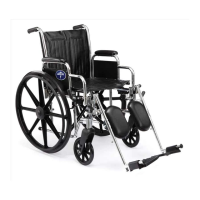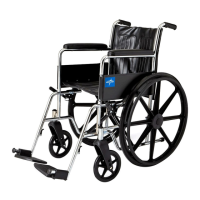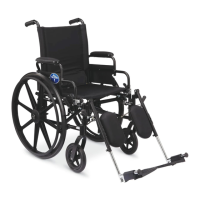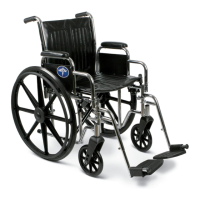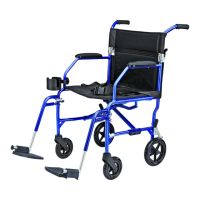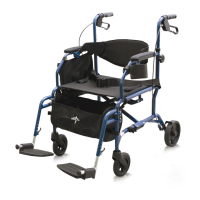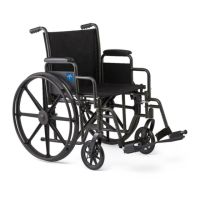GPI109
Revision: 12/16/14
GPI109
Revision: 12/16/14
8 9
GUIDELINES:
SAFETY & HANDLING OF WHEELCHAIRS
REACHING / LEANING – BACKWARD
Position the wheelchair as close as possible to the object.
Make sure the front casters are pointing in a forward position (Fig 3). This extends the wheel base and
will help stabilize the chair.
DO NOT engage the wheel locks – if your weight shifts while reaching backwards it is better for the
wheelchair to roll than to tip.
DO NOT lean back over the top of the back upholstery.
Reach back only as far as your arm will extend without changing your position in the seat (Fig 3).
TRANSFERRING INTO AND OUT OF THE WHEELCHAIR
Transferring to and from the wheelchair is a signicant task that requires balance, agility and upper
body strength. Practice with your healthcare provider before attempting transfers. If possible, always
use a transfer board and have assistance available.
• Position the wheelchair as close as possible.
• On Recliner Wheelchair models, make sure the seat back is in the upright position and the
stabilizer bar is securely in place.
• Position both casters parallel to the seat you are transferring to.
• Make sure both wheel locks are engaged.
• Remove the armrest and the footrests that are in the transfer path.
• DO NOT put weight on the foot rests.
• Transfer as far back into the seat or onto the bed/chair as possible.
OBSTACLES
Obstacles such as oor threshold strips, uneven oors, cords or items on the oor, or cracks in
pavements can damage your wheelchair and may cause loss of control or a tip over. Be alert!
Scan your path and avoid any items that may cause instability.
CURBS, STEPS AND STAIRS
Do not attempt to negotiate curbs or single steps without assistance. Ask your healthcare worker to
provide instructions regarding safe wheelchair use for curbs, steps and stairs. Proper body mechanics
and awareness of the center of gravity is crucial for these maneuvers. The step tubes (Fig. 4) at the
back of the chair are utilized to tilt the transport chair backwards until the balance point is achieved
and the front casters clear the curb/step. Gently lower the front wheels to the ground and slowly roll
the transport chair forward until the rear wheels roll up over the curb/step.
Extreme caution is required if it is absolutely necessary to maneuver an occupied chair up or down
stairs. Two assistants with adequate body strength and endurance must be present. DO NOT lift
the chair by any removable parts (i.e. swing-away footrests). Make sure the hand grips are not loose.
Techniques for going up or down steps should be received from a health care professional familiar
with wheelchair use and practiced before attempting to transport on stairs. If at all possible, an
alternate means of transport up or down stairs is recommended.
RAMPS / INCLINES
The assistant must know their capabilities and limitations in terms of strength and endurance before
attempting to go up or down a ramp. Slopes will change the center of gravity. DO NOT attempt to
negotiate steep inclines greater than 10% (6 degrees, or one foot of rise or fall for every ten feet of
ramp length) without an experienced assistant. Use of anti-tip devices are encouraged, however, they
may not prevent a tip-over. Sometimes anti-tip devices may catch at the beginning of a ramp. If this
occurs, they will need to be disengaged and extra care should be taken. Backpacks or other gear on
the back of the wheelchair will cause it to tip backward more easily. Training and practice negotiating
ramps with a healthcare professional is recommended.
• Go as straight up or down the incline as possible.
• Check the ramp for any obstacles, bumps, depressions, or wetness before beginning. Ask for
additional assistance if necessary.
• Stay in the center of the ramp if possible.
• Avoid changing direction while on the ramp as this may cause loss of control of the wheelchair.
• Avoid stopping on a ramp. Stopping may cause loss of control of the wheelchair. If stopping is necessary, avoid sudden, abrupt forward
movement when you resume propelling the chair as that could cause instability.
• When going up an incline, the occupant should lean forward. This will adjust the center of gravity to counteract the tendency of the wheelchair
to tip backward.
• When going down a ramp, the occupant should face forward and lean backward into the seat. Descent should always be done slowly.
DO NOT use wheel locks as brakes to slow down or stop the chair. Attempting to use the wheel locks could result in accidental locking,
veering or tipping to one side, or suddenly stopping.
• When going down a steep incline, the assistant should turn the chair and go down backwards to avoid tipping the occupant out of the chair.
BASIC INFORMATION FOR WHEELCHAIR ASSISTANTS / TRANSPORTERS
Work with the wheelchair user’s healthcare professional or your institution to learn safe ways to assist that are within your capability and comfort
level. To prevent injury to yourself or the chair occupant use good body mechanics:
• Always tell the rider what you intend to do so he/she is ready for your actions and can assist with maintaining a balanced center of gravity for
stability.
• Bend at the knees, not at the waist. Keep knees bent, not locked straight.
• Use legs for strength, not the back or arms. This will help prevent back strain.
• Do not twist at the waist. Keep the torso facing the same direction as the hips and move the feet to turn. This will help prevent back strain.
• Maintain a straight back. Hunching or rounding the shoulders can cause back strain.
• Do not hesitate to call for additional assistance if needed.
• If you do not feel comfortable with an activity you are requested to assist with (such as negotiating a step or a steep incline), you may decline to
assist and should help nd appropriate assistance.
• RECLINER models: Be prepared to support the weight of the rider when reclining or returning the wheelchair back to the full upright position.
• RECLINER models: Always stay in attendance when the wheelchair is in the reclined position.
GENERAL USE INSTRUCTIONS
SAFETY LAP BELT USE
The lap belt is provided to help the rider be safe and well positioned in the wheelchair. The lap belt should be initially tted by a qualied
healthcare professional or dealer. While sitting back in the chair, it should be adjusted to be sufciently tight around the rider’s pelvis to keep from
sliding down without causing discomfort. There should be sufcient room to slide a hand between your body and the belt. Adjust belt so that it
buckles in the front.
WARNING:
• The lap belt should be checked each time used for proper t. A loose lap belt could cause the user to slip between the belt and seat and risk
suffocation or serious injury.
• Check belt and hardware regularly to be sure it is securely attached and not frayed. Replace belt if worn or torn.
ANTI-TIPPERS
• Rear anti-tippers help keep the chair from tipping and are recommended attachments for additional safety (Fig 7). The use of anti-tippers is
required on Excel Recliner models.
WARNING ON USE OF ANTI-TIPPERS:
• Anti-tippers must be fully engaged. Ensure the release button of the anti-tipper fully protrudes out of the hole on the bottom of the wheelchair
frame.
• Ensure both anti-tippers are adjusted to the same height.
• A 1.5-2” clearance between the bottom of the anti-tipper wheels and the ground/oor must
be maintained at all times.
INSTALLING ANTI-TIPPERS (Included with Recliner Models)
1. Depress the release buttons (Fig 8) and insert the anti-tippers with the anti-tipper wheels
pointing toward the ground/oor into the wheelchair frame tubing.
2. Ensure that the release button of the anti-tipper fully protrudes out of the hole in the
bottom of the wheelchair frame tubing.
3. Adjust anti-tippers as necessary making sure there is a 1.5-2”/38-50 mm clearance to the
ground.
IMPORTANT NOTES:
There are potential finger pinch point areas at moving parts and between the seat frame and the seat cradles on some models. When
opening the wheelchair, take care not to place your hand or fingers between the seat frame and the seat cradles (if present) or on any
other moving parts.
ALWAYS keep hands and fingers away from moving parts. DO NOT sit in the wheelchair until the seat is completely in the open
position. Risk of injury may occur if care is not taken.
Fig. 3
Fig. 4
Fig. 5
Fig. 6
Fig. 8
Release
Buttons for
Height
Adjustment

